The fibre manufacturer Trevira has continued its restructuring process in 2012. The middle of the year saw it concentrating each of the two product lines – filament yarns and staple fibres – onto one production site (Guben and Bobingen respectively), enabling the company to increase efficiency, slim down processes and cut costs. Already prior to the restructuring process, the major part of filament yarns was produced in Guben, and here the various stages of production have now been joined under one roof, following the shutdown of filament spinning in the headquarters in Bobingen and the transfer of texturing capacity from Poland.
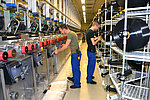
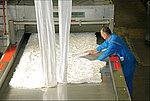
In the textile sector and in the European automotive industry the results of the continuing euro crisis can be felt. The main sales market for Trevira CS is the EU, with a large customer base in the southern European countries, and these are particularly affected by the euro crisis. Here new building and renovation projects in the contract sector are being held up (in hotels and public buildings for instance). The way raw material costs are developing is not contributing to improvement either. These have shown further increases and into next year are forecast to stay at a higher level than at the start of 2012. All the more welcome, therefore, is the fact that the number of Trevira CS trademark approvals between January and October has risen compared with the same period in 2011. For 2013 Trevira is set to continue to expand measures to support and grow the brand and to develop links with customers.
Marketing activities for Trevira CS focus on supporting all stages of the textile supply chain through customising services and especially through networking the separate stages. “The globalisation of business, continuing consolidation processes, the removal of barriers between different stages in the supply chain, and not least a changing landscape in terms of trade fairs and events, all need consideration when constructing efficient service packages. As a result Trevira started in 2012 to establish fresh highlights“, says Anke Vollenbröker, Head of Marketing & Business Development at Trevira. In May the fibre manufacturer appeared for the first time at Proposte and presented to numerous customers their Trevira contact partners for support in marketing and business development in China, Eastern Europe, the USA and the Middle East. These contacts and local support have already proved a great help to many customers. Joint participation with Gold and Silver partners at MoOD Brussels and at MoOD Yarns in September points to further cooperation with customers, who found this very positive. A new concept, the so-called Jobber Day in New York in November, was targeted at networking European weavers with local dealers. This was an opportunity for European weavers to bring European design to the USA and to set up or grow business links here. The programme finished off with matchmaking events in Europe, Asia and the USA, where contacts with decision-makers were established.
Launched in January, the Trevira CS Club went online in November of this year. Customers have been able to register and collect points by carrying out certain tasks and providing certain information. The Trevira CS Club system offers campaigns catering for the stages in yarn and fabric production, and also for editors and wholesalers. January will see announcement of the new Gold and Silver members who can call upon special services in 2013.
A particular challenge within the context of the Trevira CS Club is participation in the “Trevira CS Fabric Creativity Competition“. This offers both the larger partners and the small fabric suppliers specialising in niche products the opportunity to secure points for themselves. Selected by a panel of independent experts, the 10 best materials – picked for their degree of innovation, technical execution and trend awareness – will be especially awarded and presented at the Heimtextil Fair.
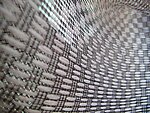
As a manufacturer of man-made fibres, Trevira is committed to act in a sustainable fashion. In this context certain projects have been launched over recent years and on its company website Trevira sets out a detailed account of its treatment of the environment and of its use of resources. In 2011 a cradle-to-gate study on the eco-balance was produced, which showed that production of flame retardant Trevira fibres is in many respects more environmentally friendly than that of cotton fibres. In the same year Trevira passed the audit to DIN EN ISO 50001:2011 and with this step integrated energy management systems into its processes.
Within the framework of the Trevira CS Club concept, Trevira, in conjunction with the editors at the Gold and Silver stage, is planning a “Book of Green Ideas“, which is aimed at architects and interior designers. The Book presents information on ecological and social themes related to the manufacture and use of Trevira CS fabrics. The aim is to impress on the minds of decision-makers in the contract market the fact that polyester fibres are able to demonstrate a positive balance from the ecological viewpoint, while at the same time generating additional functions. A further point, however, is to illustrate that suppliers of Trevira CS are among those companies who share a commitment to corporate social responsibility issues.
The largest project for 2013 is the launch of a recycling concept for Trevira CS fabrics when their useful life is over. The concept envisages that direct customers of Trevira – spinners, yarn finishers, fabric manufacturers – offer recycling possibilities for pure 100% Trevira CS textiles to their customers and/or to end consumers. Stating the trademark approval number of the article in question, users of the textiles register with Trevira and receive a sustainability and recycling pass, which authorises them to return the textiles when their useful life is over. Trevira accepts Trevira CS textiles back, which must be free of toxic substances, composites and residual materials. These are checked and – when the required quantities have been collected – proceed on to sensible recycling. In conclusion the submitting company receives confirmation that the material is being reused. Since the textiles collected have been manufactured from a single Trevira CS material, they can be used for applications where flame retardant properties are required or desirable. This could be, for instance, in sound absorption or insulation materials – possibly in panels in offices. Following the start of the system in 2013, Trevira CS partners will receive precise details on developments.
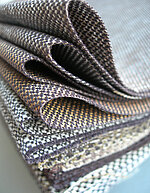

The working environment is changing, imposing increasing demands on modern office architecture that need to be considered. New ways of communicating, such as smart phones, tablet PCs and laptops, are breaking down traditional structures, and making it possible to work on the move. Thus it becomes more and more important to be able to switch from concentrated work to communicative exchange. As a result there are new demands made on the modern workplace. Its design has to take account both of networked activities and of opportunities to withdraw aside and concentrate on detail. Employees may be disturbed by noise or sounds from their surroundings and this can have negative effects on their efficiency, concentration, and ultimately on their health as well. This results in acoustic concepts becoming more and more significant in open plan offices.
Acoustic elements based on textile materials not only have the advantage that they absorb sound. They also supply a very versatile decorative element that can adapt splendidly to the particular office interior. Textile solutions to improve acoustics can, for instance, take the form of panels, partitions, ceiling panels and wall pictures. They can be used individually or in groups together, depending on the specific purpose and the degree of soundproofing desired. The use of flame retardant Trevira CS fabrics in products that improve soundproofing means they also satisfy the fire safety requirements that need to be met, in offices and public buildings for example.
Caimi Brevetti S.p.A , Italy, is one of the most important European manufacturers of design-oriented products for the office and contract sectors, and using recyclable and reusable materials, it has developed the product Mitesco, with patented Snowsound® technology. This is an acoustic panel made from a single material, polyester. The surface in flame retardant Trevira CS material is bonded with the panel to form a single element. Under the outer layer there are polyester materials of varying thickness. These absorb the sound at differing frequency ranges, providing improved soundproofing despite the low thickness of the material. The soundproofing values have been measured to UNI EN ISO 10534-2 at normal angle of incidence of sound in the Kundt’s tube. They show good soundproofing values at low frequencies (muted sounds), very good values at average frequencies (e.g. human voice) and less absorption at high frequencies (which are already absorbed by objects of furniture or by people). This results in a natural balance of acoustics. The outer surface is soft and pleasant in appearance, yet the panel is extremely robust and very hardwearing. In addition, Mitesco products with Trevira CS fabric satisfy important fire safety requirements, such as Class 1 to UNI VF 8456/8457 and Class B,s2-do to EN 13501-1.
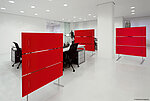
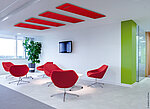
Procedes-i-d interior design GmbH, Germany, specialises in interior design in the light, sound and design segments. With its “mooia acoustic“ product range, it is possible to integrate soundproofing functionality into interior planning as a standard element of the design concept, without making the acoustic function at all visible in the process. The products consist of ultra light aluminium profiles, a sound-absorbent core and an acoustically effective textile outer skin in flame retardant Trevira CS. Sound reflection is permanently deadened, without the acoustic impact of the product being emphasised. In this way it becomes possible to combine challenging interior design with an acoustic function which is not visible but effective.
Alongside the total acoustic solutions already discussed, there are also materials available on the market where the textile itself being used already displays soundproofing properties, due to its three dimensional structure. Abinitio, Sweden, has developed a three dimensional Trevira CS knitwear, “Cullus”, where the soundproofing capacity varies in proportion to the material surface, irrespective of the form in which the knitwear article is employed. The material is washable at 30°C and available in various fabric weights and colours. Applications include, for example, panels, wall coverings, and free-hanging elements that are all acoustically effective.
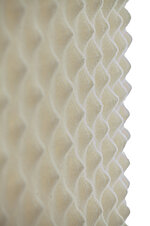

Membrane construction is another field of application for soundproofing elements, where the development of new products has led to an extension of the possible uses. Aeronautec GmbH, Germany, has developed a special acoustic screen, consisting of a free-hanging structure with 20 radially arranged banners in flame retardant Trevira CS fabric. It is 23 metres in diameter and covers a total of circa 450 m². The acoustic screen was erected in the glass-roofed inner courtyard of the Ammonhof in Dresden. Steel cables on the centre and corners of the screen are used to suspend the structure. Taken as a whole, the use of soundproofing products has increased, particularly in the office sector. New products, especially those made from recyclable materials, have expanded the design opportunities in this market. In addition to providing functionality, they create attractive solutions in the design of office interiors.
The four walls around us provide deep insights into our personality. They reveal who we are, but, more and more often, who we would like to be as well. The desire to feel good coincides with the wish to present oneself. How do others see me in my home? How can I project myself and create an image? In these days of digital social networking there is growing emphasis on revealing that which is private, to be assessed by the community. In the process one should not lose sight of individual needs. An ambience geared towards oneself has the strongest attraction to those living there, thus fulfilling its most important function: to be a home. One’s own ideas do not come from any catalogue, handwriting always remains unique. This is especially true of the way we shape our own four walls.
The main trend emphases for interiors 2013/2014 stimulate and excite. Classic black makes a sophisticated, masculine appearance – with highlights that dispel any dark associations. Fascinating three-dimensional effects bring a clean bright impact to mind, with a clearly structured effect which is anything but plain. Comfort continues to play a large role, incorporated in high quality fabrics via surfaces of rustic charm. The colour spectrum emanates warmth and harmony.
Dark energies dominate the universe. Supernatural and galactic like a real fairy tale, no one can take hold of them. The lights of distant galaxies flash against the sky - who knows the fifth element?
Colours: Black, aubergine, violet and deep brown emerge mystically. They are joined by bronze, pearl grey and silver, bringing a romantic twinkling of the eyes to the masculine theme.
Designs / fabrics: Through their looks and handle fabrics radiate dominance and power in equal measure. Architectonic severity is incorporated into the weave structures or prints. Shiny surfaces with lurex effects are set against velvet and brocade-like fabrics, while embroidery adds a decorative touch.
The film in the head starts with sudden intensity. Cool and masculine, the pulse quickens with the impressions. Facades reflect a reality that is technical and clear and yet cannot be grasped. All in 3D!
Colours: The colour spectrum stretches from a cool green-blue, through a dark emerald to cobalt green. A combination of royal blue, ultra marine and medium blue produces a total picture that excites. A pale grey provides the necessary neutral touch.
Designs / fabrics: There is a clean-cut look to the fabrics, which are, thanks to their technical qualities, totally free of opulence. Restrained designs give way to film-like sheens, to coatings and lacquer surfaces, to produce exciting three-dimensional effects.
Nature the energy-source: coming and going, constantly changing – at times too early and often too late as well. Autumn again, still a warming experience, and then all is over. Hopefully but a brief parting.
Colours: A loose combination of warm colours sets the tone. Tile red meets with bright cashmere shades, ruddy brown joins off-white, light sand nuances harmonise with wood green and petrol.
Designs / fabrics: Fabrics have a rustic effect and are highly luxurious, with a soft textile feel. Structure comes from coarse yarns; Naps, melanges and bouclé emphasize the total impact that endures.
Levity and yearning bubble up - reaching undreamt of heights. I take what I like, for all to see. My self-confidence will not take no for an answer. I do what I think is right and fight for what is mine. That’s the way I want it!
Colours: Gossamer-like shades such as lime green, pink or violet lilac present a fascinating contrast to the clarity of the whole theme. Effective use is made of radiant kiwi that can glisten as sharply as neon, while beige makes for gentle transitions.
Designs / fabrics: Fabrics are soft and flowing, with little texture. Fibre yarns of various types permit a light structure, while designs have a playful, linear impact. Striking prints display graphic patterns, both all-over and in stripes.
The Squaire at Frankfurter Airport is one of the most exciting building projects in Germany. Also dubbed the “mobility building”. The Squaire has a special and fascinating location, lying as it does above the ICE station, between two motorways. It is also directly adjacent to one of the largest airports in Europe, which stands on one side of the 660 metres long building, and on the other side there is nature in all its purity, in the shape of the Frankfurter Stadtwald (City Forest).
Even from some distance the structure radiates dynamism and mobility, and its interior reflects this likewise.
Completed in December 2011, the 34,000 square metres of both new Hilton Hotels in The Squaire should, however, offer travellers needing sleep a retreat, a place where they can wind down – a balancing act and exciting challenge for the designers. They had to bear this in mind as well when they came to select the textile components in their designs. Specialists in the hotel sector, it was possible for JOI Design from Hamburg to draw on a large selection of high quality materials. Drapes, curtains, blackouts, a large proportion of the seat and cushion covers, upholstery and surface panels in the Garden Inn, all come from Trevira CS contract collections from over 20 suppliers. They are used in the lobby, bar, restaurant, in the rooms and the conference and fitness areas as well. In making their choice, as well as suitability for contract work, of course, JOI Design considered looks, handle and naturally the appropriateness of colours and designs of materials to the total creative concept.
On arrival in the tall modern lobby, guests receive a welcome that is impressive in the truest sense of the word. After checking in, they can relax in the pleasant surroundings of the 5th Lounge & Bar, where the warm natural tones of the furnishings, together with the floral carpet, supply a relaxing flair.
In the rooms the emphasis is on slowing down. Enveloped in warm beige tones, the guest can here leave behind the noisy traffic environment and come to rest. Only in a restrained way do the waves in the carpet or the abstract motifs of the pictures pick up symbols of mobility again. A central feature is the comfortable wingback chair, given a modern interpretation, which radiates agreeable comfort.
In contrast, the natural tones in the fitness and wellness areas have a minimalist effect. In the Rise restaurant elegant shades of gold, together with well-balanced beiges and browns, create a superior dining atmosphere. Guests can dine in a sheltered environment, especially in the tall, upholstered seating niches, where their eyes are only diverted by the wooden waves that seem to hover from back-lit glass cubes, and they will wonder whether these are room dividers and not art objects.
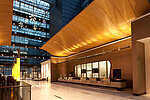
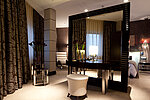
The Globe Ballroom is available for events numbering up to 570 people, its organic shape hinting at the architecture of the building as a “house within a house”. The room can, of course, also cater for larger business meetings (or when divided for smaller), and there are also various additional conference rooms off the lobby.
Equipped with many features, the Executive Lounge on Level 10 welcomes guests. Here computers sink out of sight in the lavish reception tables, whose elegant dark brown surfaces in walnut make an ideal contrast to the light blind fronts – again a slight homage to the dynamic exterior of the building. Against this, there are nooks with freestanding seating, with blinds that provide a comfortable cocooning effect. This is a place where you can work in peace, undisturbed. Guests can naturally withdraw into one of the cosy lounge areas or into the library, to pass a relaxing wait for a delayed flight. In case the traveller has to be up and about earlier, he can take an early-bird breakfast in the buffet area. The design of the Presidential Suite reflects a sophisticated internationality that is ideal for the Frankfurt location and fulfils every wish. The luxurious sleeping accommodation is set in elegant shades of silver-grey.
Slowing down, dynamism, mobility, nature and technology – “The Squaire is in all its facets one of the most unusual projects of recent years“, says Peter Joehnk of JOI Design. ”For it one needs extraordinary concepts and extraordinary materials“. www.JOI-Design.com
